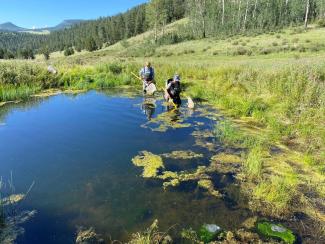Animals and Plants
The Rio Grande National Forest is home to many animals. Birds like the golden eagle, and red-tailed hawk soar above the forest. Pika and marmots live high in the mountains among the rocks and elk and deer live throughout the forested areas and open meadows. The forest often hosts spectacular wildflower displays each summer and so many pollinators and other insects also call the forest home.
Read more below to learn about some of the species of fish and wildlife living on the National Forest.
Be a Biologist
You can get involved and help the forest biologists learn more about the fish and wildlife of the area by participating in citizen science projects. Using the iNaturalist website or app you can any signs or sightings of wildlife. Signs include the sound the animal makes, a track, rub or chew marks on a tree, or scat. There are some species the forest biologists are especially interested in. Learn more by visiting the citizen science page or checking out the Forest's Plant and Wildlife Observations brochure.

Respecting Wildlife
It is important to respect wildlife while out on the forest this means not feeding wildlife and storing your food, trash, and other scented items properly so animals like bears or squirrels can not get into it. Keeping your distance from wildlife is also important.
The Rule of Thumb
You can use the “rule of thumb” to help make sure you are giving wildlife space. Hold your arm straight out and give a thumbs up. Make sure your thumb can cover the entire animal. This is a good way to help you judge distance, and in general you want to stay further away from larger animals!
Projects on the Forest
Fish and wildlife biologists work to improve habitat for all fish and wildlife species through habitat restoration projects. Other primary duties include providing input to other resource projects on the forest like recreation, vegetation and fuels management during the NEPA process. The intent is to ensure diverse and sustainable populations of native plants and animals. Fishing and Hunting opportunities are managed primarily by Colorado Parks and Wildlife, with assistance from Forest staff on population monitoring, status and trend data collection.

Wet Meadow Restoration - The Rio Grande cutthroat trout used to exist in just about every part of the Rio Grande basin, but due to a wide range of circumstances, these fish only occupy a fraction of the area they used to. Part of conservation and successful reintroduction is habitat restoration. Current restoration priorities for the program include wet meadow restoration. These projects are imitating “what the beaver dams are doing.” Learn more in the Alamosa Citizen Article.
Canada Lynx monitoring – Throughout the winter, biologists set out cameras and look for Canada lynx tracks to provide valuable information on the continued presence of the secretive cat across the Forest. They use their track identification skills to find and identify lynx tracks. eDNA is also collected to increase the confidence level of the track identification. eDNA is environmental DNA – DNA taking from water or snow to see what species are present.

Rio Grande National Forest Bighorn Sheep Monitoring - Wildlife biologists track the presence and activity of Rocky Mountain Bighorn Sheep on the Rio Grande National Forest through routine monitoring and citizen science! Rocky Mountain Bighorn Sheep, the highly valued and iconic state animal of Colorado, are at risk of developing respiratory disease contracted from domestic sheep. We document the presence of Rocky Mountain Bighorn Sheep and stray domestic sheep to help land managers protect bighorn sheep from diseases transferred from domestic sheep. We are particularly interested in bighorns that are in close proximity to domestic sheep grazing allotments and stray domestic sheep. Learn more.
Bat Monitoring - In effort to inventory and monitor bat species present on the Rio Grande National Forest, wildlife biologists deploy autonomous recording units to capture echolocation calls. These calls are unique for each species of bat and can be analyzed to determine which species are present in varying habitat types. The results of these acoustic data contribute to a continent-wide monitoring project through the North American Bat Monitoring Program. We are interested in pursuing this project to help establish baseline data that can be used to guide management actions on the Forest for bat conservation considering the rapid spread of White-Nose Syndrome; a disease caused by a fungus that has killed an estimated 6.7 million bats across North America.
Resources:
July 22, 2020 - A publication on Canada lynx was recently published in Forest Ecology and Management that describes the feline’s adaptations to the changed landscape of spruce-beetle impacted forests. The Rio Grande National Forest has seen a drastic change to the vegetation in large swaths of the forest over the past 10 years.
Learn more about fish and wildlife on the Rio Grande National Forest


